"We're not supposed to be in Cambodia but that's where I'm going." |
|
In the 1980s, there was a small wave of films in which western writers or photographers found themselves in the midst of real world conflicts where they became witnesses to terrible things being done to innocent people. Bruno Ganz was in Beirut covering battles between Christian and Palestinian fighters in Volker Schlöndorff's Circle of Deceit [Die Fälschung]; Mel Gibson played Australian journalist Guy Hamilton, whose first posting puts him slap bang in the middle of political turmoil in Indonesia in Peter Weir's The Year of Living Dangerously; seasoned combat photographer Nick Nolte became caught up in the Nicaraguan revolution in Roger Spottiswoode's superb Under Fire; James Woods played wired photojournalist Richard Boyle in Oliver Stone's electrifying breakthrough feature Salvador; and Kevin Kline was cast as South African news writer Donald Woods, whose investigation into the death of his friend Steve Biko puts his own life at risk in Richard Attenborough's impassioned Cry Freedom.
And then there was The Killing Fields, in which Sam Waterston plays New York Times journalist Sidney Schanberg, who arrives in Cambodia in 1973 just as the American Air Force has begun dropping bombs on the country, even as honest Richard Nixon is denying any US involvement. It shares common ground with each of the cinematic companions listed above. Like Salvador and Cry Freedom it was based on a well-documented true story, and like Salvador it was the work of a director with no previous experience in feature filmmaking on such a scale. In common with all of the above it is not the product of a Hollywood studio (indeed, despite outward appearances, The Killing Fields is a British production), and our first point of contact is a white male outsider on a voyage of self-discovery in an unfamiliar world – even Donald Woods is shown to be largely ignorant of the plight of his black South African brothers until he meets and is befriended by activist Steve Biko. And like several of its sub-genre companions, it is also at its heart a relationship story rather than a straight-up war film. But where the men in The Year of Living Dangerously and Under Fire fell for their attractive female co-workers, The Killing Fields, like Cry Freedom (and to a lesser degree, Salvador), is primarily concerned with the strong bond of friendship between two men.
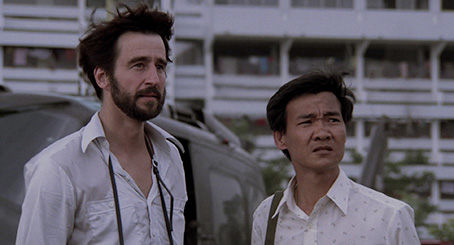
Of all of the above listed films, The Killings Fields has what on a first viewing feels like the scrappiest start. There is precious little in the way introductory scene setting, and like Schanberg himself, the film is almost defiantly presumptuous about our knowledge of world events. And back in 1984 this was a fair enough assumption, as the Vietnam war was still fresh enough in our minds, revived by the international success of The Deer Hunter and Apocalypse Now, for us to instantly recognise the context in which the events here are unfolding. Whether that would be true of a younger viewer coming to the film from a 2014 perspective is another matter. You ought to get it, but if you're not up on your modern American history then a quick bit of revision is probably in order before sitting down to watch the film for the first time.
We're not so much introduced to Schanberg as expected to run with him as he lands in Phnom Penh and arrives at his hotel. And he's not the easiest person to bond with in such a short space of time. Brusque to the point of self-righteous anger about almost everything, he berates his Cambodian interpreter Dith Pran (a compelling, Oscar-winning performance from non-professional Haing S. Ngor) for not meeting him at the airport, and howls with dismay at being teamed with hungover photographer Al Rockoff (a very early role for John Malkovich), with whom we can presume he has a bit of a history. It doesn't help that Rockoff looks like he's probably more fun than the uptight Schanberg, and with no obvious reason for his attitude problem, he initially comes across as an arrogant dick, one with none of the effortless charisma of James Woods' mesmerising portrayal of professional sleazeball Richard Boyle in Salvador. Indeed, I'd go as far to suggest that in the early scenes at least, Sam Waterston is far and away the least charismatic of the leading men in the above named films; what I didn't appreciate until I watched and listened to the extra features on this disc, is how accurate his portrayal of Schanberg is, and how important it was to screenwriter Bruce Robinson that this aspect of his personality be represented on screen. Watching the film a third time with this in mind enabled me to connect with the first third of the film in a way that I simply hadn't the first time around, although a clear foreknowledge of what was to come also helped here.
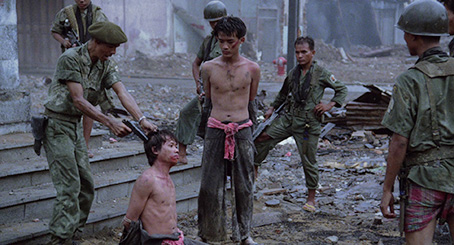
With the site of what they are told is an accidental US bombing effectively off limits, Pran's local knowledge enables Schanberg to bypass official channels, and the two men are transported to the heart of the devastation. Here Schanberg somewhat naively attempts to intimidate soldiers who are about to execute prisoners by pretending to take photos with a camera that has no film, and unsurprisingly ends up in their custody as a result. Seriously, what did he think was going to happen? He and Pran are only released when the American military turns up in force with a whole gaggle of embedded reporters, to whom they are spoon-feeding their sanitised version of events.
Two years later, the country is in political free fall. Government forces are fighting a losing battle against the Khmer Rouge and embassies are being evacuated in anticipation of the insurgents' arrival. Schanberg arranges for Pran and his family to be amongst the evacuees, but after seeing his family safely off, Pran elects to stay and continue his work with his fiend. Later, when Schanberg, Rockoff and others, including British Sunday Times journalist John Swain (a beguiling but almost elvenly pretty Julian Sands), are arrested and held by the Khmer Rouge, it is Pran's constantly pleading and negotiating that secures their release. In one of my favourite exchanges, Swain informs Schanberg that he has learned that the safest place to go if things get really bad is the French embassy. "Who told you that" asks Schanberg, to which Swain calmly replies, after a perfectly timed pause, "The British Embassy." And it's to the French embassy that the beleaguered journalists subsequently retreat and where the film really finds its narrative feet. When the order comes through that all Cambodian citizens are to be required to leave the building, Rockwell and Swain get creative in their attempts to fake an ID for Pran with next to no resources, an excitingly handled sequence whose triumphant conclusion is then painfully undercut, forcing Schanberg and his companions to abandon Pran to his fate.
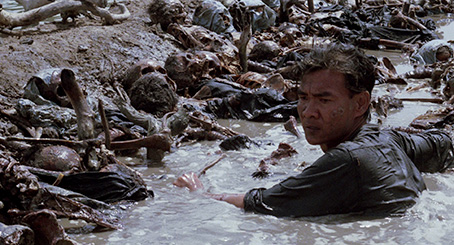
From this point on, Schanberg's story is largely sidelined to focus on what happens to Pran as a forced labour coolie under Pol Pot's 'Year Zero' policy, and it's these scenes for which the film is rightly remembered and championed. Here Robinson and Joffé strike a precision balance, unflinching in their portrayal of the unforgiving harshness and cold brutality of Khmer Rouge rule, but not demonising the soldiers to the point where they come across as cartoon action movie monsters. By keeping it real, the film makes the fear of what might happen to Pran – should his past be uncovered – all the more tangible, which makes for a seriously and consistently tense third act. And Joffé really takes a risk here by opting not to provide subtitle translations for the Cambodian dialogue, instead crediting us with the intelligence to work out what is going on from what we see rather than what we overhear. This is at its most devastating when Pran effects an escape attempt and finds himself in the midst of the killing fields of the title, and no words are needed to convey the sheer, utter horror of what he encounters. The only concessions on this score are Pran's imagined letters to Schanberg, brief internal monologues that summarise what we've seen but rarely expand on it (quite why it's essential that Pran hides his ability to speak another language, for example, is left for us to deduce), but were apparently key to the real-life Pran's almost superhuman ability to survive his torment.
Way back at the time of my first viewing, I didn't respond to The Killing Fields with the same enthusiasm that I had for Salvador and Under Fire, and watching it again three decades later it's not too hard to see why. It doesn't offer the viewer as easy an 'in' as Stone's or Spottiswoode's expertly crafted films, either in early narrative clarity or an instantly likeable central character, and engaging though the supporting players are, I never quite bought Malkovich or Sands as seasoned combat photographers in the way I believed every movement Nick Nolte made with a camera in Under Fire (almost always shooting on the move, often at speed, rarely do they pause to frame their shot or steady their camera). And I'm still not completely sold on Mike Oldfield's score, which while effectively strange/sinister in some moments of tension, comes close to overstating genuinely emotional scenes and is intermittently strident enough to draw attention to itself at the expense of what it is there to underscore.
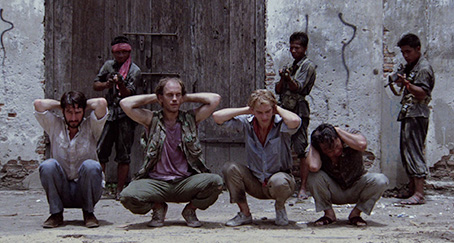
But these are minor gripes and, more importantly, my minor gripes, ones I've little doubt that others will and probably should dispute. The Killing Fields is still one hell of an achievement, particularly given the scale of the enterprise and the feature inexperience of some of the key talent involved. Robinson and Joffé's desire to make this primarily a story of a friendship is movingly realised (despite the nagging sensation that Schanberg doesn't deserve a friend as devoted as Pran), as is their intention to highlight a bloody and under-reported conflict that had previously languished in Vietnam's shadow.
It seems particularly remarkable that after some years working in television, this was Joffé's first feature (all power to producer David Puttnam here for sticking to his guns when more experienced directors were itching to helm the project), and it's thus a bit of a shame that after his follow-up film The Mission, he failed to land a project of this quality again, and subsequently fell out with Robinson after rewriting his script for the 1989 Fat Man and Little Boy. Sam Waterston, meanwhile, never subsequently made it big as a feature lead and really found his home in television as Jack McCoy in the long-running Law & Order. Bruce Robinson, of course, went on to write and direct one of the greatest of all cult movies in Withnail & I, but subsequently found writing and directing for cinema to be a frustrating and largely unsatisfying experience. Perhaps the most intriguing offshoot of the film appeared in 1987 in the shape of the Jonathan Demme directed feature Swimming to Cambodia, in which actor Spalding Gray, who has a small part in The Killing Fields as a U.S. Consul, captivatingly recalls to an assembled audience his experience preparing for his role and working on the film. If you've seen The Killing Fields you should definitely hunt it out – as companion features go, it's one of the best.
Distributors like Arrow and Eureka have set a standard for how good films from years past can look when lovingly restored, and when you're faced with a movie of this scale, ambition and budget (though not huge by big studio standards, it was still a sizeable undertaking for a British production of the period), you tend to have high expectations for how it will look on Blu-ray, especially one wearing a 30th Anniversary Edition label. I'd love to report otherwise, but the transfer here falls a little short of this ideal. The image itself is largely clean, but there's a dispiriting gloominess to the early scenes that swallows up shadow detail and at its worst makes the film look like a low-budgeter mastered for DVD rather than HD. Things do noticeably improve as the film progresses, notably in the areas of image sharpness and contrast balance – the Year Zero sequences with Dith Pran look particularly good, and the level of picture detail in the best material is strong. Colours appear to be deliberately muted throughout, and the palette has a cool hue overall. Grain is visible throughout but does not appear to have been attacked by DNR software.
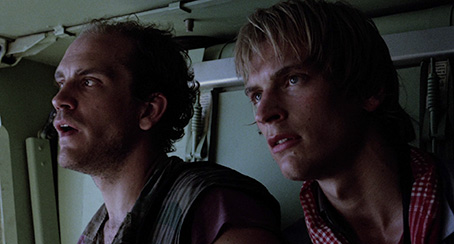
There's a choice between Linear PCM stereo and DTS-HD Master Audio 5.1 surround. Both are clear with a decent dynamic range on music and sound effects, a standard that is not quite equalled by the dialogue. The stereo track is clearly the original mix and is thus the one to go for – the 5.1 appears to be a reprocessed version of the same, one that simply spreads the music and some location effects around the room, whether they belong there or not. It also feels a little flat in comparison to the stereo track, which is lively with distinct separation during the action scenes.
Optional English subtitles for the hearing impaired are available and are occasionally useful when dialogue gets swallowed up by the chaos of surrounding noise.
Commentary by Roland Joffé
Director Roland Joffé delivers a busy and consistently informative commentary on the film, its production and the background to the events it portrays on a track that has been ported across from a previous DVD release. Kicking of with an engaging story of how he landed the job of directing his first feature, Joffé covers a lot of ground here, including the casting, how he prepared the actors for their roles, the locations, the process of shooting particular scenes, the logistics of the larger scale sequences, and a good deal more. There's a little bit of philosophising towards the end, but on the whole this is enthralling stuff.
Interview with David Puttnam (48:18)
Former producer and short-lived chairman and CEO of Columbia Pictures David Puttman answers some useful questions posed by an unseen interviewer, who at one point suggests that the music score is subtly done. You reckon? Puttnam himself is a compelling and forthright interviewee, and states without a trace of vanity that he was at his peak as a producer when he began work on The Killing Fields and that this was the high point of his producing career. Subjects covered include the preparations for the film, the negotiations to secure the rights to Schanberg's story, the determination to avoid cliché, the influence of Alain Resnais' Holocaust documentary Night and Fog, working with the inexperienced Haing S. Ngor, casting John Malkovich in the role of Rockoff, and plenty more. He intriguingly reveals that there was a good deal more footage of Schanberg in New York wrestling with his guilt in the final third of the original cut, but it was removed after a disastrous preview screening. He also believes the film should have won the Best Film Oscar because it was a lot better than Amadeus (which did win), though balances this by suggesting that his previous big success, Chariots of Fire, probably didn't deserve its own Oscar win. With you on that. This, again, is an imported extra, but a damned good one.
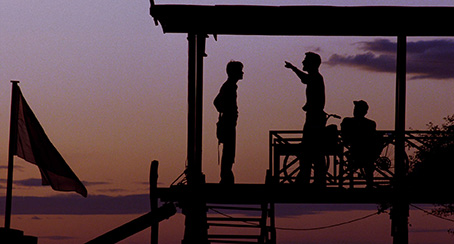
Interview with Roland Joffé (42:31)
A newly shot interview starts a little ominously with Joffé repeating the story that opened his commentary track of how he landed the job of directing the film, but soon moves into new territory, with details of his first meeting with Schanberg, the importance of male bonding relationships, working with Bruce Robinson on the screenplay, the symbolic aspects of the film, and more. Some elements of the commentary are revisited here from a different angle, and Joffé nails something that is central to any number of solid film adaptations of true stories when he quotes reporter John Swain's response to how events he was involved in were portrayed in the film: "It wasn't exactly what happened, but it was what it felt like." He also has a guarded stab at critical reaction to the film (and if the Village Voice story he tells is true, then he has good reason), and while he claims not to be anti-war, he does seem to be anti-utopia. Interesting stuff, though I did wonder if the microphone had been placed on his lap, as he seems to keep hitting it with his hands.
Interview with Bruce Robinson (21:37)
The always lovely Bruce Robinson describes how as an unknown screenwriter he landed the job of scripting the film, and intriguingly details the direction the script took after he met with Sidney Schanberg and Dith Pran. His admiration for the bravery of combat journalists is clear – after being persuaded to cross into Cambodia via a rope bridge during a research trip and clapping eyes on Khmer Rouge dressed youths, he freely admits that he stayed there for "all of 63 seconds" and blagged photos from John Swain that he told David Putnam he'd taken himself. His description of how you find the drama in a story is rather lovely: "Boy falls in love with a girl. Marries her. Parents love both of them and they live happily ever after... Parents hate each other and you've got Romeo and Juliet. And that's always what you're looking for as a dramatist."
Trailer (2:20)
Plenty of spoilers here, including how Pran's story ends, damnit.
One of the highest regarded British films of the 1980s, and after revisiting the film twice (three times if you count the commentary track) and giving the extra features the once over, I'm far more appreciative of the film's achievements than my younger self was. If you know nothing of Pol Pot and the consequences of his Year Zero policy then this will likely prove as big an eye-opener as it did for many of us who saw it on its original release, and should ideally send you off on your own research trip into the politics and conflicts of this tumultuous period. The transfer is not all it could be but does significantly improve after a shaky start, and the commentary and interviews all deliver the goods in spades. Despite the image imperfections, this still comes recommended.
|